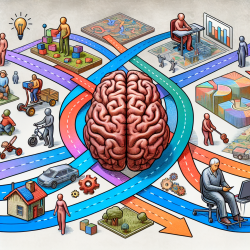Introduction
In the ever-evolving landscape of speech therapy, practitioners continually seek innovative methods to enhance communication outcomes for individuals with neurodegenerative disorders. A recent study titled "Comprehension of acoustically degraded speech in Alzheimer’s disease and primary progressive aphasia" provides groundbreaking insights that could revolutionize therapeutic approaches. This blog delves into the study's findings and explores how practitioners can leverage this knowledge to improve their skills and outcomes for patients.
The Study in Focus
Conducted by Jiang et al., the study investigates the comprehension of acoustically degraded speech in patients with Alzheimer's disease (AD) and primary progressive aphasia (PPA). The research utilized noise-vocoding, a technique that degrades speech signals by dividing them into frequency channels filled with white noise. The fewer the channels, the less intelligible the speech becomes. This method simulates real-world listening challenges, such as poor phone connections or background noise, which are common hurdles for individuals with neurodegenerative disorders.
Key Findings
- Patients with AD and PPA exhibited significantly higher thresholds for comprehending noise-vocoded speech compared to healthy controls.
- Intelligibility thresholds were notably higher in AD and the logopenic variant of PPA than in the semantic variant.
- The study identified a correlation between impaired speech comprehension and atrophy in specific brain regions, including the left planum temporale and angular gyrus.
Implications for Practitioners
These findings underscore the importance of focusing on central auditory processing rather than solely peripheral hearing functions. Practitioners can enhance their therapeutic strategies by incorporating exercises that simulate real-world listening conditions, thereby targeting the brain's ability to process degraded speech signals.
Furthermore, understanding the neuroanatomical correlates of speech comprehension can guide personalized therapy plans. By identifying specific brain regions affected in each patient, therapists can tailor interventions to address individual deficits, potentially improving communication outcomes.
Encouraging Further Research
While the study offers valuable insights, it also opens avenues for further research. Practitioners are encouraged to explore the diagnostic and therapeutic potential of central hearing measures. Investigating how these measures correlate with daily communication challenges in dementia could lead to more effective interventions and improved quality of life for patients.
Conclusion
The comprehension of acoustically degraded speech provides a window into the auditory processing challenges faced by individuals with neurodegenerative disorders. By integrating these insights into practice, speech therapists can enhance their skills and contribute to better communication outcomes for their patients. To read the original research paper, please follow this link: Comprehension of acoustically degraded speech in Alzheimer’s disease and primary progressive aphasia.










